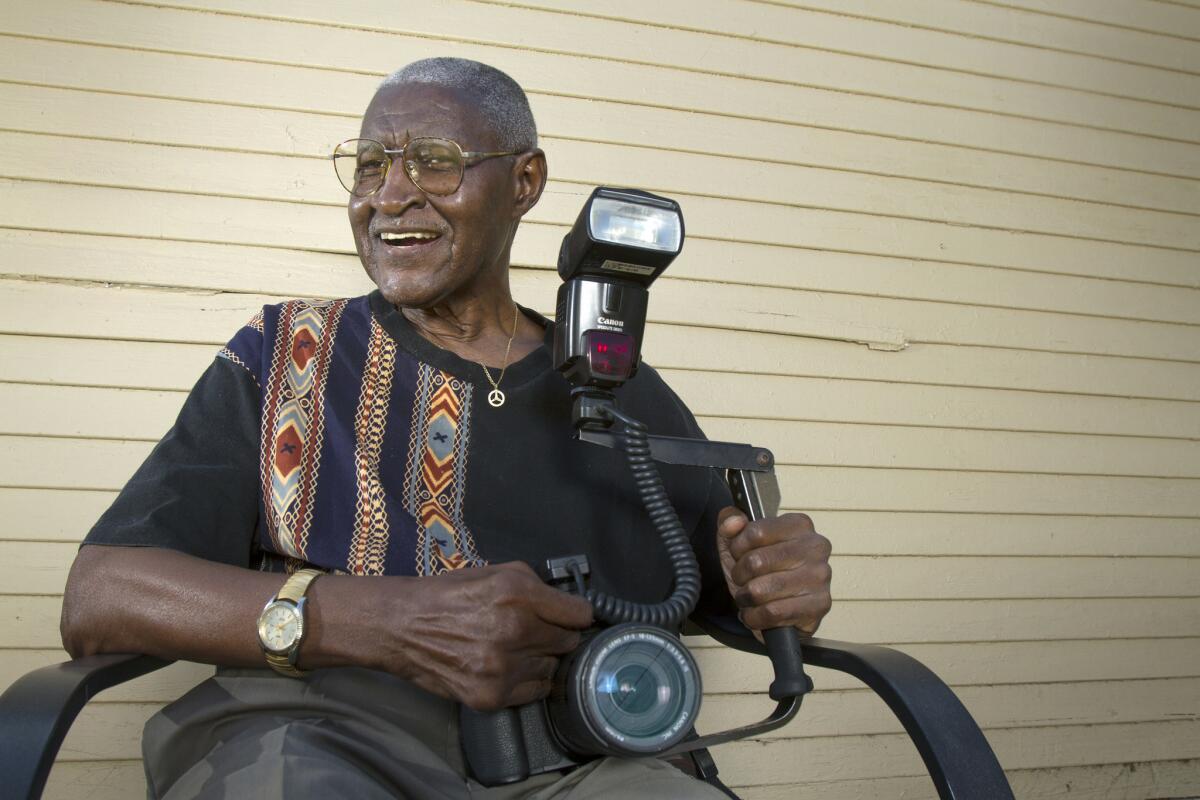Celebrity photographer Bill Jones dies at 81; captured black Hollywood, political figures and athletes

Bill Jones, a prominent celebrity photographer who chronicled the rise of black Hollywood at a time when mainstream publications often overlooked black entertainers, has died. He was 81.
Jones died June 25 in his South Los Angeles home surrounded by family and friends, according to his granddaughter Latoya Jones. He was diagnosed with dementia believed to be caused by a brain injury he suffered in a 1997 attack.
“He specialized in capturing the essence of black celebrities,” said longtime friend and fellow photographer Malcolm Ali. “He made them look good with his camera and he had a unique way of capturing them in a full-length profile that showed the good that was in them.”
A retired Air Force sergeant, Jones turned his passion for photography into a decades-long career in which he documented historic events. He snapped the Rev. Martin Luther King Jr. during his 1964 visit to Los Angeles, Nelson Mandela upon his release from a South African prison in 1990, and Halle Berry and Denzel Washington clenching Oscars in their historic 2002 win, a photo Jones called his favorite.
His work appeared in Ebony, Jet and Sister 2 Sister magazines, the L.A. Watts Times, the Wave and L.A. Focus.
Jones said that like the celebrities he covered, he had to fight for recognition in Hollywood.
“As a black man, it was very difficult at the time when I started,” he told his hometown paper, the Mansfield News Journal, in 2006. “It was tough to get a space in what we called ‘the line,’” – the line of photographers taking shots of celebrities.
Jones said white photographers would force him to stand at the end. But he charmed celebrities with his Midwestern manners. Over the years, he built a rapport with them and captured some of their lives’ proudest moments.
“Being the only black photographer, other black actors and actresses would come to me and let me take whatever pictures I wanted,” Jones said in the 2006 interview.
His goal was to be at events because he knew the mainstream media was not going to concentrate on the black celebrities.
— Malcolm Ali
“I would go to events and see how these guys will be jostling for positions,” Aldore Collier, former West Coast editor for Ebony and Jet magazines, said in a video. “The stars would go right to where Bill was standing.”
Jones shot his first celebrity photo – of Muhammad Ali — in the early 1960s while on duty as a technical sergeant with the Air Force. Later, he pursued his lifelong dream of studying photography at the London School of Photography, where he was stationed.
He retired after 22 years in the Air Force and settled in Los Angeles in 1972 with his wife, Reva. He went on to earn a sociology degree at California State University. For the next two decades, he worked as an accountant at Swinerton & Walberg. He started snapping photos as a sideline. He spent late nights covering movie premieres, award shows and galas. He gained a reputation as a photographer who could get access to famous people.
“His goal was to be at events because he knew the mainstream media was not going to concentrate on the black celebrities,” Malcolm Ali said. “Bill was that guy that made sure they were represented.”
In 1997, at age 62, Jones was washing his car outside his Hyde Park home when a neighbor bludgeoned him with a baseball bat. Authorities called it an unprovoked attack. Jones received cards and well-wishes from Sinbad, Rev. Jesse Jackson, Gladys Knight and Washington. Berry came to the hospital to pray with the family.
When he emerged from a month-long coma, he was paralyzed on his right side. At first, he couldn’t recognize his loved ones or walk, and his speech was slow and labored. His assailant, Shai Alkebulan, then 39, was arrested and sentenced to life in prison plus 13 years.
Jones spent months in rehabilitative therapy relearning basic functions. He returned to photography. Due to his paralysis, he was unable to hold anything in his right hand. He used his left hand to position his 35mm Canon camera.
To help pay for his medical care, black entertainers he had photographed feted him in a video. “When I showed up on the red carpet, he always made me feel so special,” said actress Ella Joyce, who remembers that Jones took the first photo of her to be published in Jet.
See the most-read stories this hour »
Actor Richard Roundtree considered Jones “a mainstay and a giant in this industry.” Actor Danny Glover spoke of how performers were drawn to Jones at events.
“As the years went on, his brain started to deteriorate,” his granddaughter said. “But he was still able to shoot and drive himself around” until 2013.
The son of a Mansfield, Ohio, home-appliance factory worker, he was born William Benjiman Jones in Ohio on Oct. 4, 1934. After graduating from Mansfield Senior High School, he was accepted into Ohio State University but put his studies on hold to join the Air Force, Latoya Jones said.
The walls of the home Jones shared with his wife of 54 years are covered with his work: photographs of his four children: Bill Jr., Michelle, Natalie and Nina; photographs of him with Cher, Winnie Mandela, Lena Horne, Quincy Jones, astronaut Mae Jemison. His book, “Hollywood in Black: 40 years of Photography by Bill Jones,” sits on a coffee table.
For more California breaking news, follow @AngelJennings. She can also be reached at angel.jennings@latimes.com.
ALSO
Alvin Toffler, author of 1970 bestseller ‘Future Shock,’ dies at 87
Lee Wesley Gibson, believed to be oldest surviving Pullman porter, dies at 106
Stanley Meisler dies at 85; veteran L.A. Times foreign correspondent wrote on war, art, civil rights
Start your day right
Sign up for Essential California for the L.A. Times biggest news, features and recommendations in your inbox six days a week.
You may occasionally receive promotional content from the Los Angeles Times.




